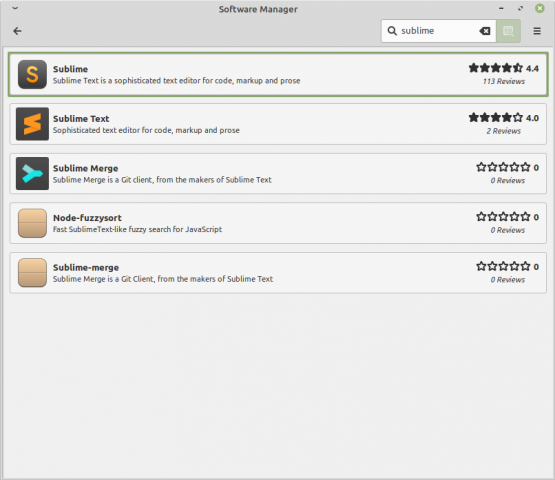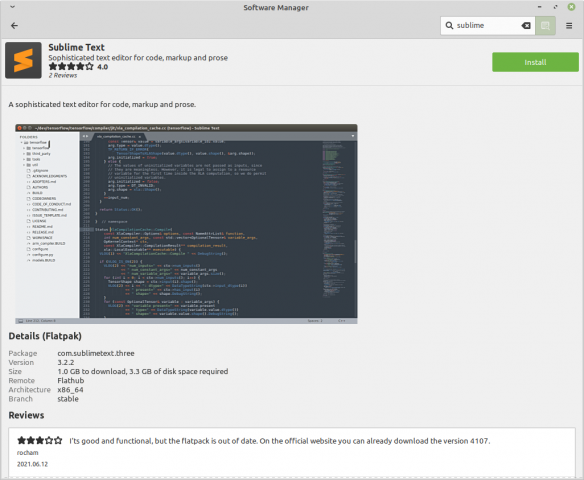Adventures in Linux Ep. 7: Just some thoughts…
…based on the reading of the latest DistroWatch Weekly issue, namely DWW Issue 925:
- Linux Mint 20.2: the Beta already was solid. I checked again all the flavors (I’ve put them on a Ventoy flash drive), and, as expected, there weren’t any bad surprises. It’s as good as it was three weeks ago when I tested the beta, meaning that XFCE is excellent, MATE is very good, and Cinnamon is unusable to me. (But I didn’t install them.)
What bothered me this time was the discovery of the fact that Flatpaks (which Mint is forcing on its users) aren’t any better than snaps (which Ubuntu is forcing on their users); they’re even worse, much worse!
OK, so with Flakpaks enabled by default, I opened Software Manager (mintinstall) to search for the Sublime Text editor, and the results were a surprise:
Two versions were offered, with different titles and different icons:
- Sublime, the package-based one, in the most recent stable release 4107:
16.2 MB to download
49.1 MB of disk space required - Sublime Text, the Flatpak-based one, in the antiquated version 3.2.2:
1.0 GB to download
3.3 GB of disk space required
What the fuck is this shit installing? Windows 11? Is this what Flatpaks are for?
While I’m still fiddling with an installed Fedora 34 XFCE (which now has much more than XFCE) for not being able to decide on something better, I was pondering on the following candidates:
- Mint 20.2 XFCE, because of the upgrade to XFCE 4.16 and the extra tools.
- Ubuntu MATE 21.04, despite snaps & Wimpy (if I wait too long, 21.10 will get released!).
- Mint 20.2 MATE, despite the lack of Yaru-MATE.
🤔 Now, I’m not sure that Mint deserves my trust. How can they ship with Flatpaks enabled, when someone who doesn’t pay enough attention—or a novice, which is exactly Mint’s target audience!—risks installing an app that takes 3.3 GB instead of 50 MB, while being an older version?
I’ll have to sleep on it some more time.
- Solus 4.3 ships with Linux kernel 5.13.1. Geez, that must be interesting. Except that Solus 4.3 MATE, the edition I tried, is full of bugs, smaller or not that small. The first show-stopper was the stupid bug in MATE Tweak: once you changed the layout from Solus to anything else, you couldn’t go back to the default layout, and all the others were using a single panel at the top. What is this crap? Either way, what with the scarcity of useful software and the lack of any third-party repository, I fail to understand why would anyone use Solus.
- Kaisen Linux added to the database: I tried it in the recent past, and I hated it. It’s a huge mess. Too bad, as I wanted to like it!
- The Feature Story, a review of siduction 21.1.1 by Ivan Sanders, is a bit dumb.
GNOME is easily one of the most popular desktop environments, far more popular than LXDE, Cinnamon, and LXQt, however I understand that these desktop environments have their own use cases such as low RAM usage, Qt environment, or GTK in the case of Xfce. I’m still shocked there is no GNOME version available from the downloads page.
Mwahaha, GNOME is for retards. And for Linus Torvalds, but not everyone is Linus (and he doesn’t use anything Debian-based).
Because siduction is Debian-based, all of these package managers are really just front-end GUIs for the famous APT package manager.
Wow, how could one have survived without this information?
The touchpad of my laptop froze very often.
I’d have liked a bit of investigation on that one. I suppose it also happens on Debian sid itself. How about the testing branch? And what hardware, exactly? If this gets into Debian 11, then it’s not good.
I had a major issue with a game I enjoy playing through Steam. I have never had any issues playing this game on any other distro, but on siduction it would freeze. I tried my absolute best to solve this issue. I thought the issue was related to SDDM (the display manager), but the issue persisted when I purged SDDM and tried LightDM instead.
This couldn’t possibly have had anything to do with SDDM! Desktop Manager is a misnomer here: these things are actually session managers, and they have nothing to do with what’s displayed when you play a fucking game! How on Earth got that past DW’s editors?!
The theming is atrocious.
No. It’s just ugly.
The KDE Wallet is irritating. Every time I login I need to give KDE the password to the wallet in order to access the Internet. Every time I open Chromium I need to provide the wallet password. I hate the KDE Wallet and I don’t understand it.
Nobody understands KWallet, and it’s possibly the most annoying thing in those distros that let KDE with the default stupid settings according to which KWallet requires all the time the fucking password for a fucking “wallet” nobody asked for!
When I restart the computer, all the programs I had running immediately start on KDE Plasma. I don’t know if this is related to KDE or to siduction but I dislike this very much. Sometimes I’ll shut down with the Konsole, Firefox, VLC, LibreOffice, Steam, etc open. I don’t expect to have to shut down a bunch of windows when I restart a computer or when I power it on for the first time in hours or days.
This stupid individual never heard of session saving? In no OS and in no DE? WTF?! Why are the most clueless morons reviewing distros on DWW? Have the summer and COVID-19 killed everyone else?
Arch has the Arch User Repository (AUR), which has nearly endless amounts of applications.
Applications, it has, but not as packages. They have to be built. I’d rather have complained about the lack of a mechanism similar to Ubuntu’s PPAs.
Now, some reader comments I agree with, at least partially:
5 • I’m not a fan of the “version freeze policy” used by Debian and distros based from it (e.g, Ubuntu, Mint), as it’s really arbitrary for most software (with exception to critical and flagship packages, such as the kernel and libraries.)
It’s not uncommon to be on a “stable” LTS version, such as Ubuntu 20.04, and be stuck with buggy software in which the upstream developers have fixed the issues, yet the package will never be in the official repositories because, heaven forbid, “version 3.0.5 is a higher number than 3.0.4!” (Even though the bug is fixed in version 3.0.5!)
How this is considered “more stable” and “safer” is beyond me. Luckily, for rolling release distros, such as Arch, Manjaro, and openSUSE Tumbleweed, you inherent upstream bugfixes (for all software, not just “crucial”) simply by keeping your system up-to-date without having to resort to PPAs, Flatpacks, and so on.
6 • I’ve seen the case made that Debian Testing is the worst of the three when it comes to security and stability because the Debian team fixes vulnerabilities and major bugs quickly in Stable and the upstream developers fix them quickly and they’re deployed immediately in Sid. But The Debian team doesn’t do the same in Testing (which they’re quite clear about), and it can take weeks to get fixes that Sid gets immediately.
9 • Niki Kovacs (aka Kiki Novak), the manager of Microlinux: No GNOME version available for Sid. Cheers to the Siduction team!
BONUS LINKS:
- Take a look at the comments (currently 135) for Ubuntu Makes a Major Theme Change For its Next Release. I had quite some fun.
- Even better with First Look: GNOME Devs Plan Dramatic Changes to Adwaita. Succulent comments (238 as I’m writing this), and I’ve found about the GTK4 bug #3787: Blurry text everywhere in GTK4. Guess what: it’s by design! “You can reopen it. But it is not a bug.” “And it is not a regression either. It is a change in font rendering.” “Not hinting is intentional, because we are doing subpixel positioning, which is basically the opposite of hinting.”




The Solus’ MATE Tweak bug is also present in Debian Testing/Bullseye. It’s broken and useless…
Slightly off-topic, but Wimpy is quite an awkward and bizarre “nom de guerre” (at least for an adult).
Right, Wimpy.
I know you think of openSUSE as some buggy mess without identity, but have you given Tumbleweed a spin in recent times? I’m curious what you might think.
I switched to it when I needed something for gaming that regularly updates Mesa and the kernel/amdgpu and is as far removed from Arch as humanly possible. At first I was a bit revolted that I’m even taking this step, but it paid off. These last two years were better for me on openSUSE than on Debian or any of the ‘buntus. I also like that the gaming stuff (Steam, Lutris, up-to-date emulators, etc.) comes directly in the official repos. And YaST is just sitting there doing nothing. You don’t actually use it unless you forget to switch off the weird-ass buggy firewall during the install procedure.
Oh, and SuSE has remained morbidly afraid of patent litigation so you don’t get sketchy codecs by default, you need the Packman repository for that. That’s my biggest gripe so far, but it’s all explained in the Wiki.
Yes, I did, and I wasn’t impressed. Sometimes, GeckoLinux ROLLING is better, some other times it’s buggier.
I cannot be made to trust openSUSE, but that’s just me.